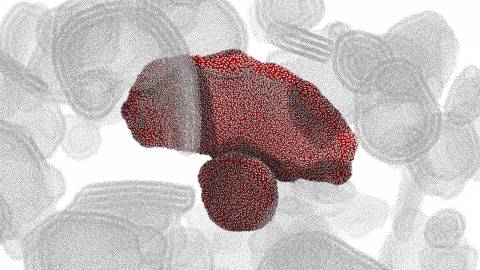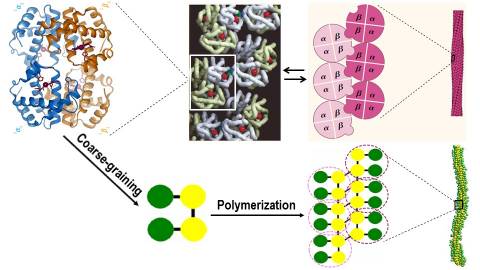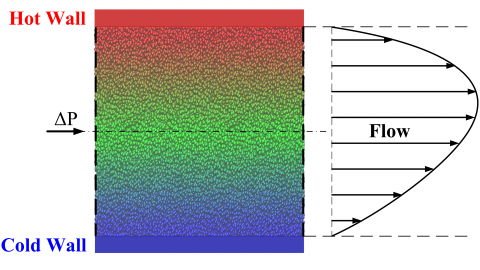Table of Contents
Crunch DPD
One of the main research areas of the CRUNCH group is to develop and employ stochastic multiscale computational techniques to diverse problems in complex fluids and soft matter. Currently, we are working on this research area developing different simulation techniques including Dissipative Particle Dynamics (DPD), Smooth DPD (SDPD), and Smoothed Particle Hydrodynamics (SPH) as well as concurrent coupling between these methods. The DPD Club meets weekly in the Division of Applied Mathematics at Brown University in order to provide opportunities for enhanced exchanges and collaborative research among researchers interested in DPD, either inside or outside of the group. Our main sponsors are the Department of Energy (DOE) via the Collaboratory on Mathematics for Mesoscopic Modeling of Materials (CM4) and the National Institute of Health.
Research Themes and Topics
In recent months, we discussed topics related to:
- Brownian motion in a channel: A memory function approach
- Boundary conditions for solid wall with arbitrary shapes in dissipative particle dynamics
- Parameter inference in mesoscopic models
- Finite volume particle method - conservativity
- Modeling blood flow in large vessels with the lattice Boltzmann method
- Shear viscosity of sickle red blood cells in shear flow
- Many-body and quantum effects in HFD-like fluid
- Electrostatic correlations near planar surfaces
- Separation of chiral particles in shear flow
- Langevin dynamics in inhomogeneous media
- Preliminary progress report on designing a universal concurrent coupling framework
- Multicsale modeling of hematological diseases
Members
—-
Weekly Seminar
Main article: List of Previous DPD Club Meeting Topics
The group holds weekly seminars. A few samples of topics discussed during the previous meetings are:
- Speaker: Prof. Petia Vlahovska (School of Engineering, Brown University)
Tension induced phase transitions in multicomponent bilayer membranes. - Speaker: Prof. Gastone Castellani (Department of Physics and Astronomy, Bologna University)
Noise and networks in biological systems: statistical connections and modeling perspectives. - Speaker: Drs. Yin-Jia Zhang (Department of Chemistry, Brown University) & Yu-Hang Tang (Division of Applied Mathematics, Brown University)
Accelerating DFT-based atomistic geometry calculations using Artificial Neural Networks and the AMP package. - Speaker: Dr. Hung-Yu Chang (Department of Chemical Engineering, National Taiwan University)
characteristics of polymersomes studied by dissipative particle dynamics. - Speaker: Dr. Dimitrios P. Papageorgiou (Department of Materials Science and Engineering, MIT)
Microfludic deformability analysis of the Red Cell storage lesion. - Speaker: Drs. Xuan Zhao & Mingge Deng
Polymer science applications of path-integration, integral equations, and fractional calculus. - Speaker: Dr. Changho Kim
Title: Uncertainty quantification for the estimation of the velocity autocorrelation function and diffusion coefficient from MD simulations. - Speaker: Dr. Zhen Li
Title: Effects of high-frequency components of the conservative force on MD-informed DPD modeling. - Speaker: Dr. Xin Bian (边鑫)
Title: Framework of concurrent multiscale coupling of Lagrangian particle methods.
Engagement
If you have done exciting work on DPD or other particle-based methods and you would like to share it with us, just contact Dr Xuejin Li, Xuejin. If you are interested in visiting us, we will cover related travelling and accommodation expenses.
Development
A couple of software projects have been actively developed within the group and available under the GPL license to the general public.
Group Publications
Main article: List of Crunch Group Publications on DPD
- L. Lu, H. Li, X. Bian, X. Li, and G. E. Karniadakis. Mesoscopic adaptive resolution scheme toward understanding of interactions between sickle cell fibers. Biophys. J., 2017, 113, 48-59. (Cover Article)
- H.-Y. Chang, X. Li, and G. E. Karniadakis. Modeling of biomechanics and biorheology of red blood cells in type-2 diabetes mellitus. Biophys. J., 2017, 113, 481-490. (BJ Highlighted Article)
- Y.-H. Tang, L. Lu, H. Li, C. Evangelinos, L. Grinberg, V. Sachdeva, and G. E. Karniadakis. OpenRBC: A fast simulator of red blood cells at protein resolution. Biophys. J., 2017, 112, 2030-2037.
- A. L. Blumers, Y.-H. Tang, Z. Li, X. Li and G. E. Karniadakis. GPU-accelerated red blood cells simulations with transport dissipative particle dynamics. Comput. Phys. Commun., 2017, 217, 171-179.
- X. Li, E. Du, M. Dao, S. Suresh, and G. E. Karniadakis. Patient-specific modeling of individual sickle cell behavior under transient hypoxia. PLOS Comput. Biol., 2017, 13, e1005426.
- X Bian, C Kim, GE Karniadakis. 111 years of Brownian motion. Soft Matter, 2016, 12, 6331-6346.
- H.-Y. Chang, X. Li, H. Li, and G. E. Karniadakis. MD/DPD multiscale framework for predicting morphology and stresses of red blood cells in health and disease. PLOS Comput. Biol. 2016, 12, e1005173.
- Y.-H. Tang, S. Kudo, X. Bian, Z. Li and G. E. Karniadakis. Multiscale Universal Interface: A Concurrent Framework for Coupling Heterogeneous Solvers. J. Comput. Phys., 2015, 297, 13-31.
- Z. Li, Y.-H. Tang, X. J. Li and G. E. Karniadakis. Mesoscale modeling of phase transition of thermoresponsive polymers. Chem. Commun., 2015, 51, 11038-11040.
- K. Lykov, X. J. Li, I. V. Pivkin and G. E. Karniadakis. Inflow/Outflow boundary conditions for particle-based blood flow simulations: Application to arterial bifurcations and trees. PLOS Comput. Biol., 2015, 11, e1004410.
- Y.-H. Tang and G. E. Karniadakis. Accelerating Dissipative Particle Dynamics Simulations on GPUs: Algorithms, Numerics and Applications. Comput. Phys. Commun., 2014, 185, 2809-2822.
- Z. Li, Y.-H. Tang, H. Lei, B. Caswell and G.E. Karniadakis. Energy-conserving dissipative particle dynamics with temperature-dependent properties. J. Comput. Phys., 2014, 265, 113-127.
- X. J. Li, Y.-H. Tang, H. J. Liang and G. E. Karniadakis. Large-scale dissipative particle dynamics simulations of self-assembly amphiphilic systems. Chem. Commun., 2014, 50, 8306-8308.
- H. Lei and G. E. Karniadakis. Probing vaso-occlusion phenomena in sickle cell anemia via mesoscopic simulations. Proc. Natl. Acad. Sci. USA, 2013, 110, 11326-11330.
- Z. L. Peng, X. J. Li, I. V. Pivkin, M. Dao, G. E. Karniadakis and S. Suresh. Lipid-bilayer and cytoskeletal interactions in a red blood cell. Proc. Natl. Acad. Sci. USA, 2013, 110, 13356-13361.
- D. A. Fedosov, W. Pan, B. Caswell, G. Gompper and G. E. Karniadakis. Predicting human blood viscosity in silico. Proc. Natl. Acad. Sci. USA, 2011, 108, 11772-11777.
- D. A. Fedosov, B. Caswell, S. Suresh and G. E. Karniadakis. Quantifying the biophysical characteristics of Plasmodium-falciparum-parasitized red blood cells in microcirculation. Proc. Natl. Acad. Sci. USA, 2011, 108, 35-39.
- I. V. Pivkin and G. E. Karniadakis. Accurate coarse-grained modeling of red blood cells. Phys. Rev. Lett., 2008, 101, 118105.
- I. V. Pivkin and G. E. Karniadakis. Controlling density fluctuations in wall bounded DPD systems. Phys. Rev. Lett., 2006, 96, 206001.
- V. Symeonidis, G. E. Karniadakis and B. Caswell. Dissipative particle dynamics simulations of polymer chains: Scaling laws and shearing response compared to DNA experiments. Phys. Rev. Lett., 2005, 95, 076001.
Ph.D. Thesis of Graduated Students
- Single Particle DPD: Algorithms and Applications. Wenxiao Pan.
- Multiscale Modeling of Blood Flow and Soft Matter. Dmitry A. Fedosov.
- Numerical Methods for Multi-Scale Modeling of Non-Newtonian Flows. Vesileios Symeonidis.
DPD Lecture Note
Useful Tools
- LAMMPS: http://lammps.sandia.gov/
- ESPResSo: http://espressomd.org/
- HOOMD-blue: http://codeblue.umich.edu/hoomd-blue/


